Polaris Versus Ski-Doo
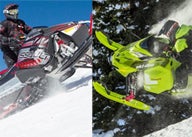
The battle rages for market share, sales and innovation
Who’s who and what’s what in the snowmobile business plays out like a reality TV show. We have four main players and, of those, the two most likely to bang skis are BRP/Ski-Doo and Polaris. Arctic Cat makes good products, but is currently Number 4 in overall revenue generation, which limits them to bench duty versus the snowmobile industry’s leaders. We’re not forgetting Yamaha, but even though the company is actually nearly three times larger in annual revenues than either Polaris or BRP/Ski-Doo, its snow12obile market share is small in comparison.
Of the four sled brands, Polaris and Ski-Doo battle for supremacy in most segments. While Ski-Doo is Number One globally, Polaris wins its shares in select and popular segments like the mountain market and Indy niches. Both companies are quite innovative, with Ski-Doo holding the edge in patents for creativity.
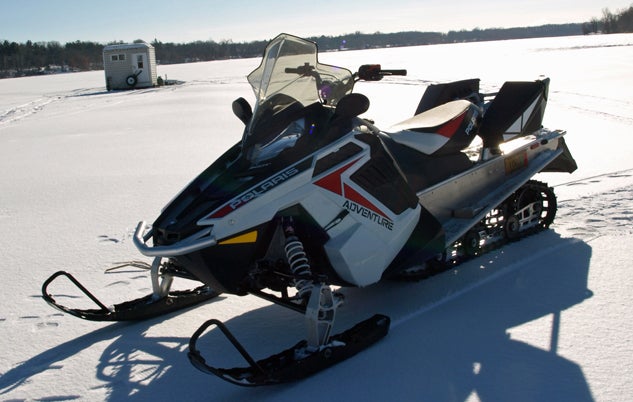 Polaris honed a value niche with its Indy line that includes two-up trail-utility sleds like the 550 Adventure model.
Polaris honed a value niche with its Indy line that includes two-up trail-utility sleds like the 550 Adventure model.Give the BRP gang credit for bringing onboard direct injection technology developed for two-stroke Evinrude outboards to two-stroke Rotax snowmobile engines. Hold your applause until we finish. BRP/Ski-Doo and its Rotax engine group developed highly efficient and advanced combustion ACE four-stroke engines that lower emissions, raise fuel efficiency and provide trail performance alternatives to its series of two-stroke twins. Then there is the whole REV platform, which managed to move snowmobilers off the rear axle and forward to a more comfortable way to ride. The move forward created a revolution in sled designs that continues to influence the 2016 models with products like the Polaris AXYS and Cat’s ProCross designs. And, wait for it, Ski-Doo innovates in a clever new way to increase steering control by moving the runner up or down in the skis. Now you can applaud.
On the other hand, Polaris holds pat with newly improved semi-direct Cleanfire two-stroke powerplants that fare very well head-to-head versus the Rotax E-TEC two-strokes. As for four-stroke innovation, Polaris opts out so far. But, when it comes to innovative niche molding, how about Polaris’ Indy, an entire line of value sleds. These models generate strong sales for the Minnesota sled pioneer. Who would have thought that a sled line built around an old order 550cc fan-cooled two-stroke and baseline 600cc and 800cc two-stroke twins would be a popular series of models? Heck, the Indy line could almost qualify as a fifth sled brand since it offers trail sports, touring, utility and adventure “value” packages with better than average ergonomics and value-added packaging.
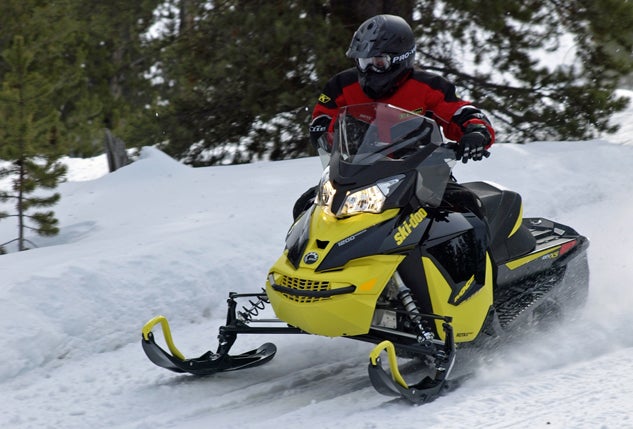 Polaris’ failure to contest the four-stroke engine segments leaves potential sales to Ski-Doo and its series of ACE and 4-TEC powered trail performance sleds.
Polaris’ failure to contest the four-stroke engine segments leaves potential sales to Ski-Doo and its series of ACE and 4-TEC powered trail performance sleds.When it comes to deep powder riders, Ski-Doo and Polaris really slug it out for market share dominance. The Polaris Pro-RMK established itself as the “go-to” sled for serious powder hounds. Just as that model started showing some age and allowed Ski-Doo’s super long tracked Summit T3 174 package to nearly supplant it, Polaris stepped up with a major 2016 model year revision that has more power and less weight. What is it that powder hounds want? How about greater power, which comes from the newest version of Polaris’ own engineered and manufactured Cleanfire 800cc twin. Then lower the weight to 408 pounds. Early reports from mountain area dealerships is that the 2016 Polaris 800 Pro-RMK is doing very well, making the Summit 174 more like last season’s news.
Looking Back at Three Million Ski-Doos
Still, Ski-Doo is Number One in the snow world. And Polaris is not. But in many ways these two companies are similar. Both are snowmobile industry pioneers. Polaris founders David Johnson and brothers Edgar and Allan Hetteen produced an industrial strength over-snow vehicle for sale in the mid-1950s. By 1959 Ski-Doo’s founder Joseph Armand Bombardier used his light-footed, wooden-skied Ski-Doo to establish “ski-dooing” as a winter recreation. Both companies started out in small towns: Ski-Doo in Valcourt, Quebec and Polaris in Roseau, Minnesota.
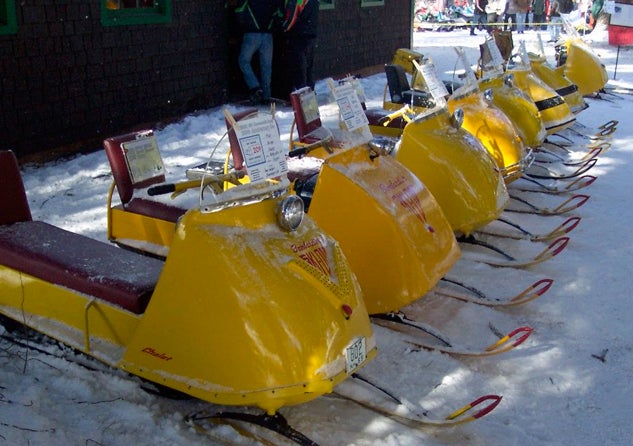 Review any vintage snowmobile event and you can see the pioneering efforts of the Ski-Doo brand from its earliest days.
Review any vintage snowmobile event and you can see the pioneering efforts of the Ski-Doo brand from its earliest days.Move ahead a half century and you’ll find that those two hometown companies are now full-fledged international corporations accounting for billions of dollars in annual revenues and supplying jobs for thousands of people worldwide. Polaris’ most recent financials reported US$4.48 billion in annual sales, which is more than halfway to its stated goal of being an US$8 billion company by 2020.
BRP/Ski-Doo reported nearly US$3 billion in sales and expects to enjoy continued growth in coming years. Currently BRP employs 7,100 people worldwide. The company states that its Ski-Doo and Sea-Doo brands are Number One in global market share.
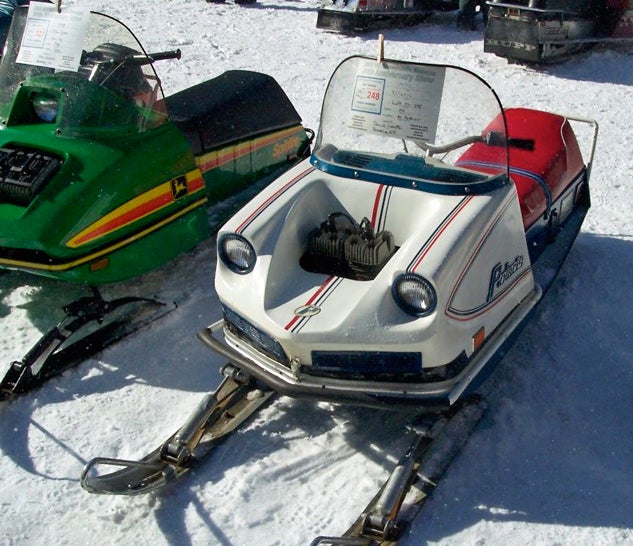 Polaris and Ski-Doo have battled for snowmobile loyalty for more than 50 years as this early 1970s Polaris Colt demonstrates.
Polaris and Ski-Doo have battled for snowmobile loyalty for more than 50 years as this early 1970s Polaris Colt demonstrates.Unlike Ski-Doo, Polaris has become less dependent on its snowmobile segment as off-road vehicles like the Sportsman ATV and RZR Side-by-Sides generate 65 percent of corporate sales versus snowmobiling’s seven percent, which is slightly smaller than sales of Polaris Victory and Indian motorcycle brands.
The history of the snowmobile market follows weather trends in which snow – or lack of snow – creates up and down cycles in sales. Over Polaris’ life span more than 100 snowmobile brands have come and gone, leaving only Polaris, Ski-Doo, Arctic Cat and Yamaha. The high point came in 1971 when approximately 495,000 units were manufactured for sale. Sled sales began a decline that hit bottom with annual sales of 87,000 units by 1983. Between 1984 and 1997 the industry rebounded to approximately 260,000 annual sales units before gradually declining through the 2012 season. The return of old-fashioned winters broke the decline as worldwide sled sales for 2014 are expected to come in around 141,000 units sold.
One Year Later: The Arctic Cat/Yamaha Deal
Polaris reports its snowmobile sales increased seven percent primarily due to the early snowfall and colder weather in North America and the success of the new AXYS chassis platform models introduced in 2014. While sales in North America improved, sales in Scandinavia and Russia decreased 28 percent in 2014 as compared to 2013 due primarily to economic weakness in the region.
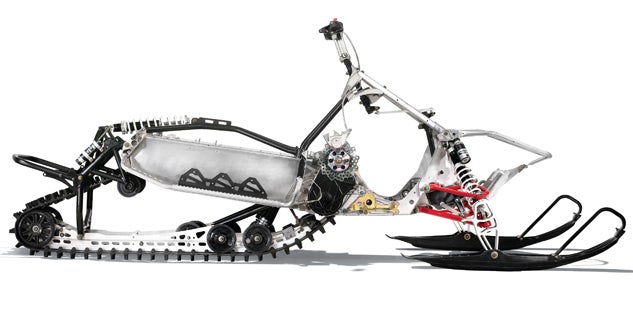 Ski-Doo’s rider-forward REV concept continues to have an impact on the competition as this view of the Polaris Switchback shows.
Ski-Doo’s rider-forward REV concept continues to have an impact on the competition as this view of the Polaris Switchback shows.Ski-Doo suffered in those geographic regions as well, reporting a decrease in its “Seasonal Products” of 3.6 percent for the three-month period ended January 31, 2015. As with Polaris the decrease came from a lower volume of snowmobiles sold in Russia and Scandinavia. But, in BRP’s case, lower sled sales were somewhat offset by an increased volume of Sea-Doo Spark watercraft.
Both companies not only battle for market share in the snow world, but also off-road with ATVs and Side-by-Sides. While BRP doesn’t have a motorcycle component to its business like Polaris, the company’s Can-Am three-wheelers are dominant in that “motorcycle” segment. Of course, Polaris decided to play in that segment, too, having introduced its Slingshot three-wheeler with side-by-side seating instead of a motorcycle style.
As with any good reality show, you have interesting characters. Both of these two corporate characters, Polaris and BRP, started out as snowmobile pioneers and survived more than a half-century, using their snowmobile roots to build bigger and more profitable corporations. Now with more than 50 years of competing head-to-head, each company seems to use its history as competitors to bring out better and better snowmobile products as a result. Each pioneer trying to out-do the other. Now that’s a reality that’s good for us all.
| Polaris | Ski-Doo | |
| Annual Sales | US$4.48 Billion | US$2.80 Billion |
| First Snowmobile | SnoTraveler 1955 | “Ski-Dog” 1959 |
| Number of Employees | 7,800 | 7,100 |
| Products Sold In | 100+ countries | 105 countries |
| Areas of Sales Competition | ||
| Off-Road Vehicles | ATVs & Side by Sides | ATVs & Side by Sides |
| Snowmobiles | #1 in global market share | |
| Three-Wheelers | Slingshot | Can-Am Spyder |





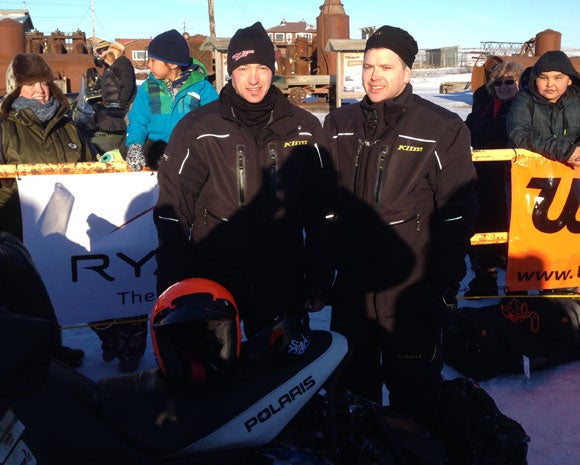


 Your Privacy Choices
Your Privacy Choices